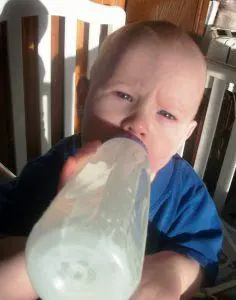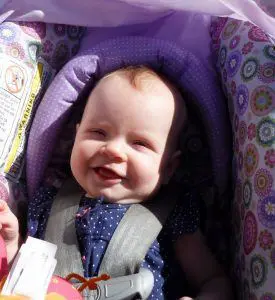When your baby goes from crying to communicating with actual words is a proud and useful milestone in the memory book, but what do you do if that milestone is delayed? When is a baby’s speech development considered delayed? At six months one of our sons had only-recognizable-to-those-closest to him words, but at nearly a year old his brother rarely and only quietly expressed even the tiniest of verbal communication such as “up.” The question then became, did one of our children have a language delay? The answer was in the baby speech development timeline.
How does baby speech develop?
Baby speech development begins before your baby is even born. Research shows that in the final 10 weeks of pregnancy your baby hears you and takes the first step in developing speech– listening. This is why newborn tend to be comforted more by familiar voices and will respond better to speech in their native language. This absorption of language sounds continues and soon your baby forms the connection that sound can express wants, a lesson which is well reinforced in the early months by frequent screaming.
Common milestones for infants between birth and 3 months include:
-startling at loud sounds
-showing reaction to voices (being calmed, changing expression, etc.)
-recognizing care giver voices
-cooing, gooing, and signs of happiness
-cries differently to express different needs/feelings
Later, your baby begins to connect where sounds are coming from and make sounds that more closely recognize speech. Making the following common between 4 and 6 months of age:
-looking in the direction of noises
-babbling including letters sounds
-listening to music
-laughing
-cooing, gurgling, or making sounds to express different emotions
Finally, random letter sounds lead to imitation as your baby begins to mimic sounds and form actual words. Between 6 and 12 months most infants begin:
-to mimic sounds
-play peekaboo
-understand common words, such as “cup” or “nap”
-follow simple one-step directions, such as “come here”
-Repeat letter sounds in sentence-like gibberish
-Communicate with gestures
-Say a few simple words (mom, dad, hi, bye are common)
So, when should your baby start talking?
It turns out neither of our sons had a language delay. As the baby speech development timeline above is variable, language skills are not considered delayed unless no recognizable words whatsoever are said by 15 month of life. Concerns over language delay like mine are common, but often misdiagnosed. Having a child that’s slow to talk is also not a reflection on you. As long as you are talking to your baby often and giving her/him the chance to hear language, you’re doing just fine. Every baby is just different. Often a baby that lags behind in one developmental area may excel in another.
What should you do if you suspect a language delay?
First, there are some cues your child may have an underlying developmental issue prior to that 15 month cut-off.
Warnings of an infant language delay include:
-Doesn’t react to sounds.
-Doesn’t make eye contact or attempt to communicate with you or suddenly stops doing so at any point.
-Doesn’t use gestures as non-verbal forms of communication by 12 months of age.
-Doesn’t try to imitate sounds he or she hears often by 12 months of age.
-Doesn’t babble (random sounds) by 12 months of age.
If your baby isn’t doing any of the above, it’s a good idea to speak with your pediatrician to confirm a language delay, try to figure out what’s causing it, and help your child get back on track.
Common causes of language delay in infants include:
-Hearing loss (partial or complete)
-Learning or intellectual disabilities
-Auditory processing disabilities
-Autism
-Structural problems in areas vital to speech
-Being born premature
-Neurological disorders which may or may not be associated with other medical conditions
-Speech disorders such as Apraxia of speech
-Selective mutism
-Neglect (a baby that is not interacted with enough to hear language will not learn to speak)
Many of the above are correctable or at the least their effects on language can be minimized if caught early on.



